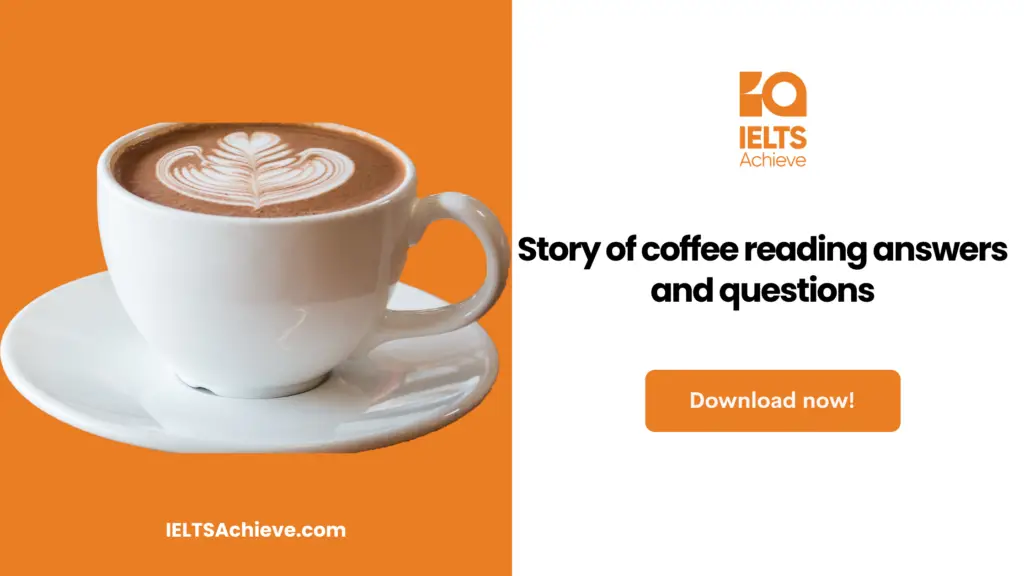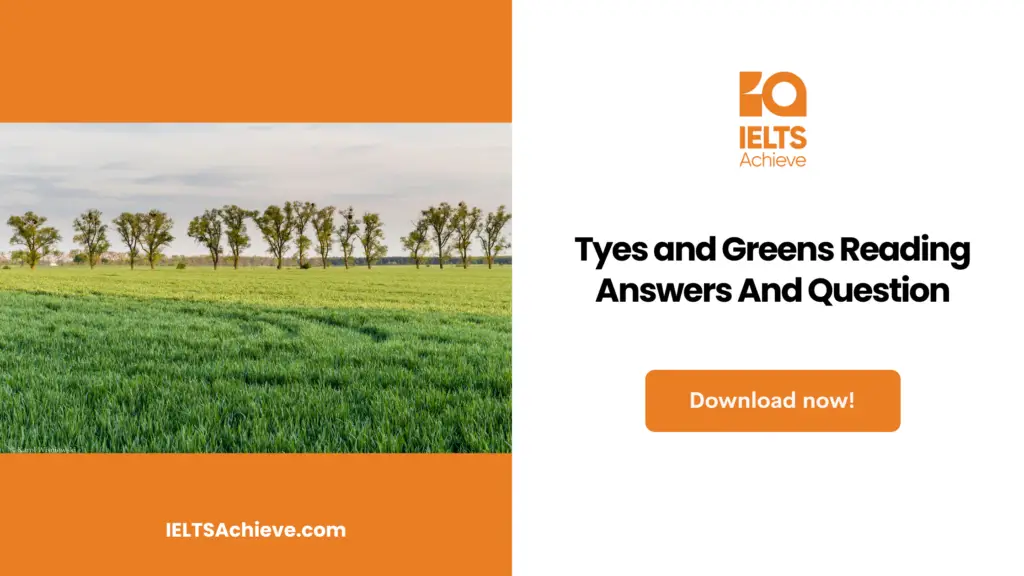The Blog post contains the following IELTS Reading Questions:
- IIELTS reading matching headings
- IELTS academic reading diagram labelling
- IELTS reading Flowchart completion
Stay informed and prepared for success – Explore our comprehensive Reading Test Info page to get valuable insights, exam format details, and expert tips for mastering the IELTS Reading section.
IELTS Reading Passage: Story of coffee

Story of coffee
Coffee was found in Eastern Africa, in what is now known as Ethiopia. Classic folklore tells about a goat herder named Kaldi who noticed his goats getting strangely frisky after eating berries from a shrub. Kaldi, intrigued by this phenomenon, tried eating the berries himself. He discovered that eating these berries provided him with more vitality.
The story of this high-energy fruit spread swiftly throughout the region. Coffee berries were carried from Ethiopia to the Arabian Peninsula, where they were first grown in what is now Yemen. Coffee remained a well-guarded secret in Arabia until moving to Turkey and eventually to Europe via Venetian trade traders.
Coffee was originally consumed as a meal, but later in Arabia, people boiled the beans to form a drink for its narcotic and therapeutic properties. Coffee was once known as Arabian wine among Muslims who were prohibited from using alcohol by Islam. It wasn’t until after coffee had been consumed as a food product, a wine, and a medication that it was found, most likely by chance in Turkey, that roasting the beans produced a delightful drink. The roasted beans were crushed and then cooked in water to make a rudimentary form of the beverage we know and love today. In the 17th century, the first coffee cafes appeared in Europe, and in 1675, the Viennese created the practice of refining the beverage by filtering out the grounds, sweetening it, and adding a dash of milk.
If you were to search the world for coffee, you would discover over 60 types of coffee plants growing wild in Africa, Malaysia, and other areas. Yet, just around 10 of them are farmed. Two of these 10 species account for nearly all of the coffee produced worldwide: Coffea Arabica and Coffea Canephora (usually known as Robusta). Due to ecological variations across coffee-producing nations, both kinds have experienced several mutations and currently exist in a variety of subspecies.
Although wild plants can grow to be 10 – 12 meters tall, cultivated plants are only around four meters tall. This facilitates harvesting and flowering and reduces cultivation costs. The blossoms are white and fragrant, similar to Spanish jasmine. Flowers give place to a reddish-brown fruit. At first glance, the fruit appears to be a large cherry, both in size and color. The fruit is covered in a thin crimson film (epicarp) that contains a white, sweet mucilaginous flesh (mesocarp). Within the pulp lie the seeds, which resemble two beans joined at their flat surface. The beans are then covered with a tough, golden-yellow paper (called an endocarp). When peeled, the true bean is seen with a very thin silvery covering. The bean is blue-green with golden undertones, measuring no more than 11 millimeters long and 8 mm broad.
Coffee plants require specific conditions in order to produce a decent yield. The climate must be hot-wet or hot temperate, located between the Tropics of Cancer and Capricorn, with regular rains and temperatures ranging from 15 to 25 degrees Celsius. The soil should be deep, hard, permeable, and well-drained, with a subsoil that drains properly. The best lands are those that are steep or come from newly-tilled woodlands. The ideal altitude range is 600 to 1200 meters, while some species flourish above 2000-2200 meters. Plant protection cultivation is required at all stages of growth. Sowing should take place in covered nurseries, and seedlings should be relocated to plantations in the rainy season, where they are generally interspersed with other plants to protect them from wind and excessive sunshine after around six months. Only once the plant has reached the age of five years can it be depended on to provide a consistent output. For each plant, this is between 400 grams and two kilograms of arabica beans and 600 grams and two kilos of robusta beans.
Harvesting time is determined by geographical location and can thus vary substantially between producing nations. The ripe beans are first harvested from the trees. Pickers can precisely pick 250 to 300 pounds of coffee cherries every day. The pickers haul their heavy burlap sacks to pulping mills at the end of the day so that the cherry coffee may be pulped (or wet milled). The pulped beans are then left to ferment overnight in clean rainwater. The wet beans are hand-distributed to the drying floor the next day to be sun-dried. Depending on the number of sunny days available, this drying procedure might take one to two weeks. The beans must be scraped many times during the drying process to ensure equal drying. After two weeks, the sun-dried beans, now known as parchment, are picked up, packaged, and transported to be processed. The parchment and silver skin is next removed by massive milling machines, resulting in a green bean suited for roasting. The green beans are roasted according to the demands of the consumers, then packed and delivered to the customers.
Unlock your full potential in the IELTS Reading section – Visit our IELTS Reading Practice Question Answer page now!
Recommended Questions:
Renewable Energy IELTS Reading Question with Answer
Story of coffee IELTS Reading Questions
Questions 1-6
The reading passage on The Story of Coffee has 7 paragraphs A – G. From the list of headings below choose the most suitable headings for paragraphs B – G.
Write the appropriate number (i–xi) in boxes 28–33 on your answer sheet.
NB There are more headings than paragraphs, so you will not use them all.
i. The Coffee Spread
ii. Coffee from the Arabian Peninsula
iii. Climates Suitable for Coffee
iv. Varieties of Coffee
v. Issues with Manufacturing
vi. Initial Contact
vii. The Coffee Tree
viii. Producing Coffee
ix. Coffee Consumption
x. Preparing the Bean
xi. Coffee in the Modern Era
Example Answer
Paragraph A iv
- Paragraph B – _____
- Paragraph C – _____
- Paragraph D – _____
- Paragraph E – _____
- Paragraph F – _____
- Paragraph G – _____
Ready to conquer Matching Headings questions? Click here to learn essential tips and techniques for matching headings accurately to paragraphs or sections in the IELTS Reading section.
Questions 7-9
Complete the labels on the diagram of a coffee bean below. Choose your answers from the text and write them in boxes 7-9 on your answer sheet.

(34) – ______
(35) – ______
(36) – ______
Ready to tackle Diagram Label Completion tasks with confidence? Click here to access our comprehensive guide and learn how to accurately label parts or components of diagrams in the IELTS Reading section.
Questions 10-13
Using the information in the passage, complete the flow chart below. Write your answers in boxes 10-13 on your answer sheet.
Use NO MORE THAN THREE WORDS from the passage for each answer.

(37) – _____
(38) – _____
(39) – _____
(40) – _____
Boost your performance in Summary, Notes, Table, and Flowchart Completion tasks. Click here to explore our detailed guide and learn how to effectively complete summaries, notes, tables, and flowcharts in the IELTS Reading section.
Unlock your full potential in the IELTS Reading section – Visit our IELTS Reading Practice Question Answer page now!
Recommended Questions:
Renewable Energy IELTS Reading Question with Answer
Story of coffee Reading Answers
1. i
2. ix
3. iv
4. vii
5. viii
6. x
7. Epicarp
8. Mesocarp
9. Endocarp
10. Wet milled
11. Overnight
12. Scraped
13. Consumer’s demand

We hope you found this post useful in helping you to study for the IELTS Test. If you have any questions please let us know in the comments below or on the Facebook page.
The best way to keep up to date with posts like this is to like us on Facebook, then follow us on Instagram and Pinterest. If you need help preparing for the IELTS Test, join the IELTS Achieve Academy and see how we can assist you to achieve your desired band score. We offer an essay correction service, mock exams and online courses.

